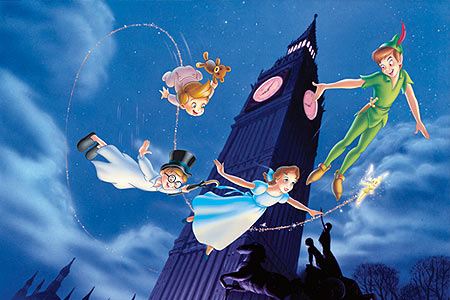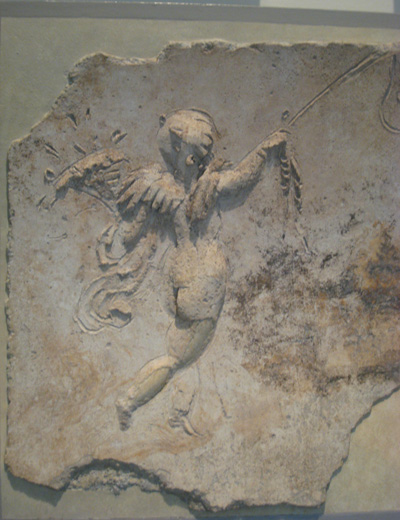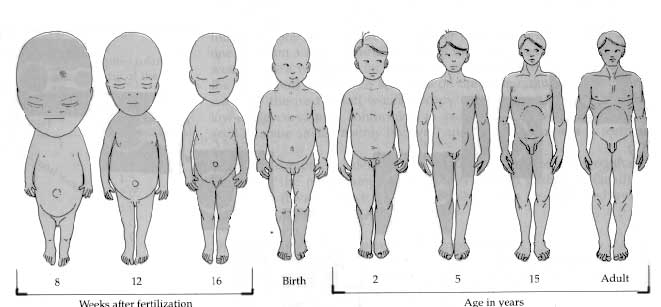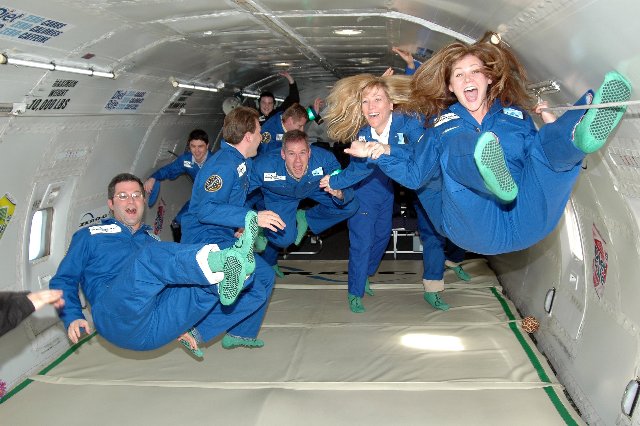| Tweet
|
|
The
Star Larvae Hypothesis
Nature's Plan for Humankind
Addendum: Cyberfetus Rising
-
Cyberfetus Rising -
Technology decommissions the specialized adaptations of the adult body. The neoteny that results illustrates gene-culture coevolution. In outer space the process will deliver a posthuman form that the religious figure of the cherubic angel, or putto, the celestial infant, anticipates.
Humankind's extraterrestrial descendants, living in the weightlessness of outer space, will have removed themselves from their terrestrial kin, not only geographically, but also physiologically and psychologically.
Bones and muscles atrophy in weightlessness, a physiological deterioration troubling to astronauts. Brains, however, are likely to react to long-term weightlessness in the opposite way. They are likely to hypertrophy, or become super enriched. This one-two punch, delivered by weightlessness, will infantilize extraterrestrials. Like babies, ETs bear proportionately big, enriched brains compared to their small, atrophied limbs.
That is, weightlessness will induce, or elicit, a neotenous response from developing bodies. As a result, native extraterrestrials will resemble human infants more than they will resemble human adults. Space colonists also will be reproductively isolated, more or less, within each colony. These several circumstances set the stage for a posthuman speciation, members of the new species being characterized by truncated development relative to their contemporaries on Earth.

Fable and folklore seem to anticipate such a fate. Examples of juvenilized skywalkers include the stereotypical UFO pilot, with its fetal allometry (big head, small limbs); Peter Pan, the eternally youthful high-flyer; the cosmic fetus that closes out Kubrick's 2001, A Space Odyssey, and the winged putti, the flying babies of Renaissance and Victorian art. These and similar cultural forms anticipate the evolutionary trajectory.

Among
the extraterrestrial tots, the St. Valentine's Day Cupid
seems most eager to advance the evolutionary program.
As a symbol, the figure of cupid combines neoteny—retarded development— with sexuality, and does so weightlessly, a sure-fire recipe for speciation. As Ecologist
Ramon Margalef notes in Perspectives
in Ecological Theory, "The
opening of new spaces to colonization creates new opportunities for the
development of new species; such evolution does not take a slow and regular
path but proceeds through neoteny or other nonhabitual or poorly understood
evolutionary paths."
What space is more likely to trigger nonhabitual modes of speciation than outer space?
The general trend in human evolution already is neotenous. Humans are the juvenilized descendants of apish ancestors, according to at least some evolutionary theorists, including paleontologist Stephen Jay Gould. And because the neotenous trend is likely to accelerate and intensify under the influence of weightlessness, humankind's extraterrestrial descendants eventually might not develop beyond the form of the fetus, the embryo or even the zygote—the newly fertilized ovum— this trajectory being dictated by the pattern of development common to complex organisms and which technology undermines.
|
The archetypal putto is shown here on Greek stone reliefs. |
|
Each complex organism begins life as a single-celled zygote, which divides into an undifferentiated clump of cells. The cells give rise to specialized tissues. As the organism develops—as its ontogeny unfolds—it acquires more of the anatomy and morphology characteristic of its adult form. The tails, fangs, and wings that grow more conspicuous as organisms develop constellate into a distinctive bodily form, the adult form, of the species. Rat, whale and ostrich embryos share a common form, initially, then differentiate into their specialized adult forms as they develop.
(Nineteenth-century German naturalist Karl Ernst von Baer recognized the developmental trend from a general form to a specialized one. Among biologists, Von Baer's observation has replaced the so-called biogenetic law of Ernst Haekel as the favored view. Haekel's law is summarized in the well known formula, "Ontogeny recapitulates phylogeny," which means that during development organisms pass through the adult stages of their ancestors. This formula persists in popular contexts, even though scientists today disregard it. In 1988 the president of the National Academy of Sciences concluded, "The biogenetic law is as dead as a doornail" ["Ontogeny and Phylogeny Recapitulated," American Scientist, May-June 1988]. Haekel's biogenetic law predicts that neotenous descendants should resemble ancestral adults, in contrast to von Baer's law of progressive differentiation, according to which neotenous descendants resemble the juvenile form of their ancestors.)
 |
All complex organisms share a common morphology—initially. They acquire their distinctive, specialized adult forms as they develop. By retarding development, neoteny produces adults with juvenile features. This de-differentiation of morphology provides adaptive advantages in rapidly changing environments, including, one has to suppose, high-tech environments. |
Technology Extends, then Supplants, the Body
In unstable, rapidly changing environments, neoteny—retarded development—enables organisms to leave behind adaptations that have outlasted their usefulness. As for the environmental changes that promote human neoteny, technology seems to be a player. The work of anthropologist C. Loring Brace provides an example of the evolutionary effects of technology. Brace discovered adult human skeletal remains that are peculiarly retarded—they're toothless. Brace explains the connection to technology: "Human skeletal collections from the Neolithic and subsequent periods contain the remains of individuals who had survived for years in a completely edentulous [toothless] state. No such evidence is available for any human population that did not use pottery. Pounding, grinding, and milling tools also become common late in the Pleistocene . . . and it seems likely that this may also have contributed to the relaxation of Pleistocene levels of selection, which had maintained large amounts of tooth substance." (Brace, C. Loring, Karen R. Rosenberg, and Kevin D. Hunt, "Gradual Change in Human Tooth Size in the Late Pleistocene and Post-Pleistocene," Evolution, 41(4), 1987, pp. 705-720. See also, "Human Teeth, Small Already, Continue to Shrink," The New York Times, August 30, 1988.)
Food-processing technologies reduce the need for big teeth, a body's grinding and milling tools. Big teeth might be unable to return the metabolic investments that they require, once automation technologies, such as pounding, grinding, and milling tools—extensions of the teeth—become available. This observation can be generalized to cover technologies per se.
"The
first tools were probably conceived initially as simple extensions of
the human body," generalizes David Barash in The
Hare and the Tortoise: Culture, Biology, and Human Nature, "the club a stylized and more powerful hand and fist, the bowl
and pouch more efficient cupped hands, the flint scraper a heavy-duty
fingernail. . . ." Marshall McLuhan made the same observation.
His opus, Understanding
Media, he subtitled "The extensions of man." Philosopher
Jean-Francois Lyotard defines the same relationship in The
Postmodern Condition: "Technical devices originated as prosthetic
aids for the human organs or as physiological systems whose function
it is to receive data or condition the context."
As physical
capacities get extended technologically, the body parts that provide those capacities atrophy, as do teeth when they compete with food-processing technologies.
L. Frank Baum, author of the early OZ books intuited this side effect of technology. The tin
woodsman of Oz originally was a man of ordinary flesh and blood. But, as he worked, his
ax would rebel and chop off parts of his body. A tinsmith replaced each
severed part until the woodsman was remade entirely of tin. Technology
had supplanted the body completely, the comprehensive prosthesis suggesting a robot. Mircea Eliade cites another version
of this motif, in The
Two and the One:
"The celebrated 'rope-trick' of the fakirs and conjurers creates the illusion that a rope rises very high in the sky, and the master makes his pupil climb it until he disappears from view. The fakir then throws his knife into the air and the young man's limbs fall, one after another, to the ground."
Here the blade's—technology's—cleaving of body parts is associated with ascent. And the motif is pervasive. Though associated mostly with India, Eliade finds examples in cultures as far flung as those of China, Mexico, and Ireland.
Overall, the technological
environment turns out to be a milieu of gadgets whirring and chugging in
space and time in lieu of human bodies. Freud, for one, welcomed the concomitant prosthetic
effect. In Civilization
and Its Discontents,
he declares, "With every tool man is perfecting his own organs,
whether motor or sensory, or is removing the limits to their functioning.
Man has, as it were, become a kind of prosthetic God. When he puts on
all his auxiliary organs he is truly magnificent."
—
Charles Lumsden and Edward O. Wilson
Promethean
Fire: Reflections on the Origin of the Mind
—
Jean Baudrillard
on Disneyland, in Simulations
It might be that normal evolutionary pressures for metabolic economy enable tools to supplant the body parts that they simulate (and outperform). By extending the functions of specialized body parts, technology relaxes selection pressures for the maintenance of those parts. McLuhan called the process, "autoamputation." As a result of this dynamic, technological development and neoteny proceed hand in hand.
The ability
of tools to shape phenotypes finds a more formal theoretical foundation
in the gene-culture coevolution model of sociobiologist Edward
O. Wilson. Humankind was synthesized by "a sustained autocatalytic
reaction in which genetic and cultural evolution drove each other forward," Wilson
and colleague Charles Lumsden propose in Promethean
Fire. "This
largely unknown evolutionary process we have called gene-culture coevolution:
it is a complicated, fascinating interaction in which culture is generated
and shaped by biological imperatives while biological traits are simultaneously
altered by genetic evolution in response to cultural innovation."
Although Wilson and Lumsden tend to restrict their use of "culture" to behaviors, clearly the concept must include artifacts, implements, devices—technology. The notion of "epigenetic rules" that they use to link genes and social behaviors in a feedback relationship applies as readily to the linking of genes and the crafting and use of tools as it does to the linking of genes and social behaviors. In this view, a species that modifies its environment technologically—that is, one that constructs niches—becomes locked into an evolutionary feedback circuit in which it and its technologies mutually shape one another in a symbiosis. This kind of insight has inspired research among evolutionary biologists working under the banner of niche construction theory.
Techneoteny—The Primary Mode of Gene-Culture Coevolution
Neoteny and technology feeding off each other—techneoteny—appears to be humankind's primary mode of evolution. Neoteny is an adaptation to the manufactured environment. This adaptation sometimes is called domestication.
Richard C. Francis develops the theme of neotenous domestication in "Domesticated: evolution in a man-made world". The book covers the histories of a variety of domesticated animals and makes the case that, while they are not the same process, domestication and neoteny travel in tandem, with tameness. He observes,
“We have seen that a number of the convergent traits wrought by domestication are paedomorphic, often a combination of a generally slowed rate of development (neoteny) and accelerated sexual maturation (progenesis). But neoteny is not a universal feature of domestication, as evidenced by its absence in domesticated cavies and other rodents. The only universal feature of domestication is tameness. Neoteny is one avenue to tameness through the retention of juvenile behavior by means of decelerated development of the stress response and perhaps some key limbic neural circuits.”
Describing the domestication of aurochs into cattle, he observes, “The body size of males and females converged, for example, even as both were getting smaller. The same was true of horn size. Males also became more like females behaviorally—much less aggressive than their wild progenitors and hence more sociable. As in pigs, all of this sexual convergence came about through relaxed sexual selection in the human environment. In some cases, no doubt, this trend was augmented by conscious selection for tamer bulls.”
“Reduced sex differences may also be by-products of selection for tameness, which, as we have seen, often comes by way of neotenic alterations in development. Males are the slower-developing sex, maturing two to three years later than females; hence neoteny would tend to affect males more, especially their late-developing traits, such as horns. The general reduction of horn size in both sexes may also be a neotenic feature, as well as the shortened snout and legs, which are part of the domestic phenotype package.”
Other examples Francis cites: “Neoteny born of selection for tameness may also play a roll in the reduction in tusks and other sex differences among domestic breeds [of pigs]. Tusks are a late-developing character, so if development is slowed or truncates, they’ll be smaller or absent altogether. The reacquisition of tusks in feral pigs may, in part, be explained by the reversion to a wild-type developmental trajectory. The shortened faces of pigs, as well as the floppy ears found in many breeds, also suggest neoteny.”
Of ferrets, he observes, “But the most marked physical alteration is in the skull, which is broader and shorter than that of polecats This sort of change in skull shape, as we have seen, along with the behavioral changes is an indicator of paedomorphosis—the retention of juvenile traits in sexually mature adults. Indeed, the ferret is in may ways a neotenic polecat.”
Of felines, he observes, “It has been proposed that neoteny is at work in the sociability of domestic cats. Meowing, purring, and kneading are all kittenish traits retained by adult domestic cats but not adult wildcats. While kneading may just be a nonadaptive (selectively neutral) by-product of infantilization, the purr and meow are important social signals.”
Francis cites many other examples of “domesticated phenotypes,” with neoteny being a key aspect of the several constellated attributes that constitute the "domesticated phenotype." If technology tends to domesticate the creatures that it serves, then the bodies of those tamed creatures will tend toward the neotenous. This is to say that what was true of the grinding tools and pottery of Neolithic cookery should be true of subsequent generations of invention: each should contribute to the autocatalytic cycle of neotenous gene-culture coevolution.
If we fast forward from the Pleistocene to the present, we see the gyre tightening and taking a greater toll on the more highly differentiated gender, the male. Though technology tends to be associated with the prerogatives of the masculine, it produces environments increasingly hospitable to the feminine.
A Man's World?
Physician and writer Havelock Ellis noticed
this trend already at the end of the nineteenth century. In his Man
and Woman: A Study of Human Secondary Sexual Characters,
he observes, "Savagery and barbarism have more usually than not been
predominantly militant, that is to say masculine, in character, while
modern civilization is becoming industrial, that is to say feminine, in
character, for the industries belonged primitively to women, and they
tend to make men like women." This feminization is neotenous, Ellis
contends, citing what he calls the "infantile diathesis" of
women: "When women differ from men, it is the latter who have diverged,
leaving women nearer to the child-type. Women are nearer to children
than are men [and] the child represents a higher degree of evolution
than the adult."

Trends
in Allometry: Terrestrial human ontogeny reads from left to right.
Post-terrestrial post-human phylogeny reads from right to left.
The ancient
world also recognized a link between the industrial and the feminine.
Some early practitioners of metallurgy, for example, built their lore on a mythos of gestation
and incubation. "Very early on we are confronted with the notion
that ores 'grow' in the belly of the Earth after the manner of embryos,"
Mircea Eliade comments in The
Forge and the Crucible: The Origins and Structure of Alchemy, "Metallurgy thus takes on the character of obstetrics. Miner and
metalworker intervene in the unfolding of subterranean embryology: they
accelerate the rhythm of the growth of ores, they collaborate in the work
of Nature and assist it to give birth more rapidly." Eliade goes
on to cite the traditions of the Atonga, who "have a custom of throwing
into the furnace a portion of the placenta to ensure the success of the
smelting."
—
Aleister Crowley
Little
Essays Toward Truth
Mary Shelley's
Frankenstein assigns
a more overtly anthropomorphic form to the industrial
feminine. Critics conventionally interpret the story through the
lens of its Promethean subtitle, but critic Steven Lehman interprets
it as an allegory of male womb envy. He argues, "[Dr. Frankenstein's] problem—and
it is the central thematic problem of the novel—is that modern science
obviates the biological gender distinctions upon which our psychology
and society have been built." (Lehman, Steven, "The Motherless
Child in Science Fiction: Frankenstein and Moreau," Science Fiction
Studies, No. 56, 1992, pp. 49-58.) Technology cures Dr. Frankenstein's
womb envy by enabling him to give birth to artificial life. It allows
Victor Frankenstein to mother the prototypical problem child. If technologies
extend the body, then inventing is akin to birthing.

More recently, male womb envy has taken a digital turn. Computer programmers have adopted the creation of "artificial" or "virtual" life as a technical grail. Bold programmers claim that their growing, replicating, and adapting software constitutes a new life form. Such Frankensteinian aspirations maybe express the male urge to deliver life, but, despite any joy that they might derive from their ersatz motherhood, the men of industry craft their own undoing.
In The Mechanical Bride McLuhan renders an image of male impotence at the hands of industry: "Under complex conditions of rapid change, the family unit is subject to special strain. Men flounder in such times. The male role in society, always abstract, tenuous, and precarious compared with the biological assurance of the female, becomes obscured. Man the provider, man the codifier of laws and ritual, loses his confidence." Given the dire circumstances, a men's movement may have been inevitable. Poet Robert Bly, a central figure in the men's movement of the 1990s, winces at the link between industry and immaturity: "If you walk from Boston to Labrador, you’re more mature when you arrive; If you drive, you’re more infantile when you arrive. The Industrial Revolution brought central heating and the automobile. Not only does maturity fail, but a positive movement toward regression is taking place. There’s a connection between technology and infantilism. It’s sad." (Interview in EastWest, March 1986, p.72.) Despite technology’s more immediate undermining of traditional male roles, the specialized roles of both male and female seem destined ultimately to converge on, or retreat toward, the generic child type. "The wolf shall dwell with the lamb, and a little child shall lead them," as the prophet foresaw.
— Nietzsche
Thus
Spoke Zarathustra
Myth and folklore often describe the first human as an androgynous creature, then account for the androgyne giving rise to gendered descendants. Similarly, a fertilized ovum—first human—is not obviously male or female, but differentiates anatomically along gender lines as it develops. And myth and folklore also often describe a reintegration of the genders that restores the original, undifferentiated, androgynous form. Extraterrestrial human descendants will stage this alchemical script, as they revert phenotypically toward infantile, and developmentally earlier, morphologies.
Mircea Eliade makes note of a mythological connection between the androgynous form and divinity: "Certain apocryphal texts use paradoxical images to describe the Kingdom or the overturning of the Cosmos occasioned by the coming of the Saviour. It is to be noted that these images are used side by side with those of androgyny and of a return to the state of a child."
Today family members gather around the electronic hearth
to consume popular cultural fare, with adults and children alike content to
watch cartoon shows and eager to imbibe celebrity sex scandals.
Psychological de-differentiation and cultural de-differentiation reinforce one another. "Being
There,"
Jerzy Kozinski's parable of the divine naif, captures the trend. The novel's
protagonist, "Chauncey Gardiner," grows up in seclusion, nursed
by a TV. The tastes, concerns, and socialized personality of a normal
adult never take root in him. The plot expels a disoriented Gardiner
into the adult world, his only social skill being his ability to rattle
off folksy platitudes. Ironically, innocence proves disarming. Gardiner
ascends the political ranks and lands in a position of magical influence.
He assumes a political function along the lines of the Reagan administration's White House astrologer, Ms. Joan Quigley, an oracle.
"Being There," in its movie form, suggests the next stop in humankind’s neotenous evolutionary trip. Director Hal Ashby takes liberties with the novel when the infantile Chauncey Gardiner makes clear the allegory by walking on water. By deifying the naif, the weightless conclusion of "Being There" prescribes a sidestapping around humankind's otherwise terminal, planetbound regression.
Off planet, gravity yields to levity.





Space Colony: The Extended Womb
Technology's extension of the body would seem to culminate in a comprehensive technological surround. Within an all-encompassing synthetic-prosthetic environment, biological metabolisms can stop investing in specialized adaptations left over from ancestral environments. The encapsulated ecosystem of the space colony is such a comprehensive environment—the body extended in toto, in effect an exo-womb.
In Freudian fashion, the project of human industry aims at the engineering and
construction of an immortal mother. Within an immortal mother, biology can
remain eternally embryonic. This is where the feminine energies inherent
in industry complete their mission, as the collection of industries takes
the form of a comprehensive synthetic womb. Weightlessness adds the finishing
touch of authenticity. Evolution is preparing to spawn intrauterine extraterrestrials.
Philosopher Herbert Marcuse, in Five
Lectures: Psychoanalysis, Politics and Utopia,
saw the logic in technology's potential to complete itself by turning
inside out and liberating libido from its discontents:
"The achievements of repressive progress herald the solution of the repressive principle of progress itself. It becomes possible to envisage a state in which there is no productivity resulting from and conditioning renunciation and no alienated labor: a state in which the growing mechanization of labor enables an ever larger part of the instinctual energy that had to be withdrawn for alienated labor to return to its original form, in other words, to be changed back into energy of the life instincts. It would no longer be the case that time spent in alienated labor occupied the major portion of life and the free time left to the individual for the gratification of his own needs was a mere remainder. Instead, alienated labor time would not only be reduced to a minimum but would disappear and life would consist of free time."
— Ashley Montague
Growing Young
On Earth,
the birthing transition from womb to world is a traumatic one. In the
weightless exowomb of the space colony, human descendants might barely notice the
transition—a
smooth glide from one buoyant comprehensive life-support environment
into another. In weightlessness the purported benefits of underwater
birthing will be put to the test. The psychological effect on future
generations of the elimination of the
trauma of birth
is a topic tangential to this writing but one ripe for speculation.
—
Arthur Koestler
Janus:
A summing up
Nonetheless, this much seems evident: the developmental transition from Freudian psychology's Pleasure Principle to its Reality Principle, a transition that in the Freudian model accounts for much psychological distress and dysfunction, might be sidelined in a space-based civilization. A fetal mentality could remain unchallenged and unadulterated in an environment that reproduces with sufficient fidelity the life-support functions of the womb. The weightless technologically comprehensive environment of the space colony recalibrates all standards of psychological and physical adaptation, because it promises to radically truncate psychological and physical development through retardation.
An extreme prospect is that of the unfettered expression of oncogenes. These genes would seem to be natural vehicles for neoteny, because their job is to retard cellular differentiation. Masses of undifferentiated tissue occur twice during the lives of complex organisms: once early in embryonic development and later in the form of the cancerous tumor. Both occurrences involve oncogenes. In the course of embryologic development, cells differentiate into the diverse tissues of the adult organism. But tumors don't differentiate. They remain undifferentiated tissue. What’s more, given a sufficiently supportive culture, these undifferentiated masses—neoplasms—behave oddly. They don't die. This peculiarity of tumors contributes another mythical dimension to the star larvae hypothesis. It suggests a literal heavenly immortality.
"Prominent among the kinds of cell lineages potentially immortal in culture are cancerous ones; hence the study of such cells in culture has been vigorously pursued in recent years," writes William T. Keeton of Cornell University in the college textbook "Biological Science" (third edition, 1980, W. W. Norton and Company). "The HeLa cell line is derived from a carcinoma of the cervix of a young black woman named Henrietta Lacks, who died of her cancer in 1951. This was the first stable, vigorously growing line of cultured human cells used in cancer research. Today HeLa cells are found growing in medical and research laboratories the world over."
"Culture" denotes an engineered environment that preserves its occupants in a state of arrested development, whether that environment be the cosmopolitan milieu that is the neotenous urbanite's habitat or the petri dish habitat of the laboratory tumor. Cancerous neoplasms in this context appear to be premature posthuman extraterrestrials, as if they were mutations waiting for appropriate environments (weightless cultures) in which to emerge as evolutionary players. As bodies and technologies fuse, and today's virtual reality systems evolve over generations into semisynthetic skins that mediate molecular exchanges between body and environment, evolution in space will erase the distinctions that distinguish Gaia and Techne. Both will be subsumed into a generic, extropic stuff, an amorphous technorganism.
— Lynn Margulis
Symbiotic
Planet: A New Look At Evolution
This prospect suggests all kinds of alien morphologies and the potential for a new endosymbiosis. The original endosymbiosis was the process by which ancient bacterial cells, prokaryotes, merged to form the first eukaryotic cells, the complex cells that make up plant and animal bodies. The juvenilizing effects of weightlessness presumably will retard all species, not just humans. Assuming that our descendants haul their pets and possibly livestock into space, the several species will revert together and converge on their common embryonic form. And the tendency already is in place. What earlier was referred to as "techneoteny" is essentially the process of domestication, which is technology-driven juvenilization. House cats are domesticated felines, companion dogs are domesticated canines, and humankind is the domesticated primate. Each domesticated species is neotenous relative to its wild ancestors and contemporaries and is a potential contributor of genes to an aggregate descendant. The convergence of species inside a weightless solid-state environment will set the stage for an exo-Cambrian explosion of evolutionary novelty. The animal rights and humane farming movements might be setting the stage for, or be early expressions of, such an interspecies convergence.
Already we can see that the element silicon, as electronic circuitry and solar-energy cells, will play a leading role in the transition, and, in good science-fiction form, might even replace carbon in part or whole as the main building block of organisms—though at that point biology will have evolved/metamorphosed into something postbiological. The reappearance of silicon at the end of biology mirrors its initiating role, a parsimonious symmetry.
Ultimately, the microscopic devices known collectively as nanotechnology, acting as intracellular prostheses, could enable coils of DNA and their epigenetic regulators to control technological systems remotely. Nanotechnologies, if realized as advertised, could function as prostheses for the tools of molecular genetics. They might obsolesce RNA molecules, amino acids, ribosomes, and the other machinery of protein synthesis. The overlooked dimension of nanotechnologies is their potential to translate genetic blueprints for cells, organs, and organisms directly into microprocessors, supercomputers, and space colonies—and other prosthetic extensions of cells, organs, and organisms.
Something superhuman is weaning itself of its dependence on human beings.
That thing is the local expression of the universe's ontogeny. The religious vision turns out to be merely clairvoyant, not transcendent—Heaven is the sky, a weightless niche within which angels evolve.
NEXT > Exo-Psychology Revisited



The solarized feminized extraterrestrial carried by neotenous attendants.
The Star Larvae Hypothesis:
Stars constitute a genus of organism. The stellar life cycle includes a larval phase. Biological life constitutes the larval phase of the stellar life cycle.
Elaboration: The hypothesis presents a teleological model of nature, in which-
Stellar nebula manufacture bacteria and viruses in their interiors as they cool.
-
Biology evolves within an ontogenetic program that in its entirety, on- and off-planet, constitutes a generational life cycle of the stellar organism.
-
Technology plays a necessary role in evolution. It enables biological life to emigrate from planets to weightless space.
-
Postplanetary life manufactures the protons needed to create, then metamorphoses into, new stars.
-
A prescient complex of celestial religious motifs expresses humankind’s stellar calling. The star is the human imago.
-
Nature's metabolism encompasses the organic and the inorganic in a continuum of anabolic and catabolic exchanges.
| Tweets by @Starlarvae | |
| |
Home | Blog | About | Videos | Contact | Text Copyright ©2004-2017 Advanced Theological Systems. All Rights Reserved.
Privacy Statement: We use third-party advertising companies to serve ads when you visit our website. These companies may use information (not including your name, address, email address, or telephone number) about your visits to this and other websites in order to provide advertisements about goods and services of interest to you. If you would like more information about this practice and to know your choices about not having this information used by these companies, visit the Google ad and content network privacy policy.
